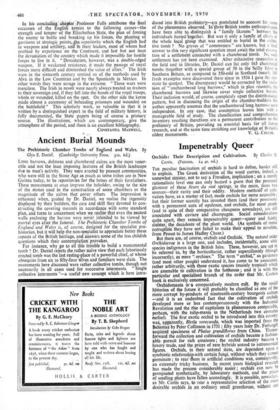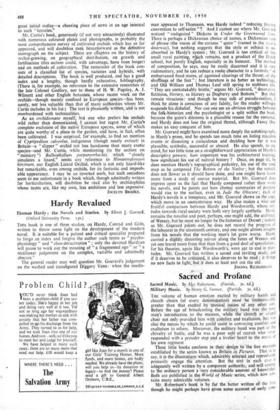Impenetrably Queer
Orchids: Their Description and Cultivation. By Charles H. Curtis. (Putnam. £4. 4s. od.) THE peculiar fascination of orchids is hard to define, harder still to explain. The Greek derivation of the word carries, indeed, a somewhat sinister, not to say a Freudian, implication; on a merely rationalistic level one can only hazard a guess that the perennial glamour of these fieurs du mal springs, in the main, from two sources—their rarity and their oddity. Modern methods of culti- vation have, as a matter of fact, made orchids far more accessible ; but their former scarcity has invested them (and their possessors) with a permanent aura of opulence, and orchids, for most people (and in spite of their comparative cheapness nowadays), are still associated with caviare and champagne. Social considerations quite apart, they remain impenetrably queer—queer and faintly sinister, the decadents -of the plant world. (As symbols of moral corruption they have not failed to make their appeal to novelists, from Proust to James Hadley Chase.) But there are, of course, orchids and Orchids. The natural order Oraidaceae is a large one, and includes, incidentally, some sixty species indigenous in the British Isles. These, however, are apt to be referred to, by the horticulturist, rather superciliously (though incorrectly), as mere ‘`. orchises." The term "orchid," as gardeners (and most other people) understand it, has come to be associated, rather arbitrarily, with those exotic species (mainly tropical) which are amenable to cultivation in the hothouse and it is with this particular and specialised branch of the order that Mr. Curtis's book is exclusively concerned. Orchidomania is--; comparatively modern cult. By the social historian of the future it will probably be classified as one of the more corrupt by-products of nineteenth-century bourgeois culture —and it is an undoubted fact that the cultivation of orchids developed more or less contemporaneously with the Industrial Revolution and the tise of capitalism (a phenomenon coiriparable, perhaps, with the tulip-mania in the Netherlands two centuries earlier). The first exotic orchid to be introduced into this country wai, apparently, Bletla verecunda, which was imported from the Bahamas by Peter Collinson in 1731 • fifty years later Dr. Fothergill acquired specimens of Phaius graniliflorus from China. Thence- forward the collection and cultivation of orchids became a fashion- able pursuit for rich amateurs ; the orchid industry became a luxury trade, and the prices of rare hybrids soared to astronomical figures. Orchids, in their natural state, are dependent upon a symbiotic relationship-with certain fungi, without which they cannot germinate ; to rear them in artificial conditions wai, consequently an extremely tricky business. In recent years biological research has 'made the process considerably easier ; orchids can now be germinated synthetically, by laboratory methods, and the prices of seedling plants have fallen accordingly. It is possible nowadays, as Mr. Curtis says, to rear a representative selection Of the more desirable orchids in an ordinary small greenhouse, without allY
great initial outlay—a cheering piece of news in an age inimical to such "luxuries."
Mr. Curtis's book, generously (if not very attractively) illustrated with numerous -coloured plates and photographs, is probably the most comprehensive survey of cultivated orchids which has so far appeared, and will doubtless rank henceforward as the definitive monograph on the subject. There are ettapters on the history of orchid-growing, on geographical distribution, on growth and fertilisation (this section could, with advantage, have been longer) and on methods of cultivation. The remainder of the book con-•
sisti of a classified list of species, varieties and hybrids, with detailed descriptions. The book is well produced, and has a good index and a lengthy, though hardly exhaustive, bibliography. (There is, for example, no reference to the extensive researches of the late Colonel Godfery, nor to -those of H. W. Pugsley, A. J. Wilmott and other English botanists; whose recent work on the orchids—though mainly confined trr European species—has been, surely, not less valuable than that or many authorities Whom Mr. Curtis includes in his list.) The text is pleasantly written, arid is not overburdened with technicalities.
As an orchidomane myself; but one who prefers' his: orchids wild rather than domesticated, I cannot but regret Mr. -Curtiss complete exclusion of the native European species, some of which are quite worthy of a place in the garden, and have, in fact, often been cultivated. I was surprised, fof-example, to find no mention of Cypripedium calceolus, indigenous (though nearly extinct) in Britain—a " slipper " orchid not less handsome than many exotic species—and Mr. Curtis, while mentioning (in the section on "mimicry ") BuThophyllum purpureorhachis, which "closely simulates a lizard," omits any reference to j-jimantoglossum hircinum, our English Lizard Orchid, which is not only lizard-like but remarkable, even among orchids, for its fantastic and improb- able appearance. I may be an inverted snob, but such omissions seem to me unfortunate in a book which, though admittedly written for horticulturists, will doubtless be read also by orchidophiles whose tastes are, like my own, less ambitious and less expensive.
JOCELYN BROCkE.



















































 Previous page
Previous page